Functional Identification of the Dextransucrase Gene of Leuconostoc mesenteroides DRP105
Abstract
1. Introduction
2. Results and Discussion
2.1. General Genome Properties
2.2. Gene Analysis of Dextransucrase
2.3. The dsr Gene Deletion of Leu. mesenteroides DRP105
2.4. Metabolic Analysis
3. Materials and Methods
3.1. Strains and Culture
3.2. Phylogenetic Analysis
3.3. Genome Sequencing and Assembly
3.4. Genome Annotation
3.5. Dextransucrase Gene Analysis
3.6. Construction of the dsr Gene Knockout Vector
3.7. Mutant Construction
3.8. Cre-Mediated Mutant Locus Resolution
3.9. Assay of Growth Profiles
3.10. Nucleotide Sequence Accession Numbers
3.11. Statistical Analysis
4. Conclusions
Author Contributions
Funding
Conflicts of Interest
References
- Feng, J.; Cai, Z.; Chen, Y.; Zhu, H.; Chang, X.; Wang, X.; Liu, Z.; Zhang, J.; Nie, G. Effects of an exopolysaccharide from Lactococcus lactis Z-2 on innate immune response, antioxidant activity, and disease resistance against Aeromonas hydrophila in Cyprinus carpio L. Fish Shellfish. Immunol. 2020, 98, 324–333. [Google Scholar] [CrossRef] [PubMed]
- Caro-Astorga, J.; Álvarez-Mena, A.; Hierrezuelo, J.; Guadix, J.A.; Heredia-Ponce, Z.; Arboleda-Estudillo, Y.; González-Munoz, E.; De Vicente, A.; Romero, D. Two genomic regions encoding exopolysaccharide production systems have complementary functions in B. cereus multicellularity and host interaction. Sci. Rep. 2020, 10, 1000. [Google Scholar] [CrossRef] [PubMed]
- Purama, R.K.; Arun, G. Dextransucrase production by Leuconostoc mesenteroides. Indian J. Microbiol. 2005, 45, 89–101. [Google Scholar]
- Patel, S.; Goyal, A. Isolation, characterization and mutagenesis of exopolysaccharide synthesizing new strains of lactic acid bacteria. Int. J. Microbiol. 2010, 8, 3–4. [Google Scholar]
- Zhao, B.; Du, R.; Wang, J.; Xu, M.; Han, Y.; Han, X.; Zhou, Z. Purification and biochemical characterization of a novel glucansucrase from Leuconostoc citreum B-2. Biotechnol. Lett. 2020, 42, 1–11. [Google Scholar] [CrossRef] [PubMed]
- Li, B.L.; Zhao, L.; Wang, C.F.; Xin, D.; Ding, X.Y.; Liu, F.; Huo, G.C. Genomic and phenotypic characterization of the biosynthesis pathway of exopolysaccharides in Streptococcus thermophilus KLDS3.1012. Food Sci. 2019, 40, 136–142. [Google Scholar]
- Remaud-Simeon, M.; Willemot, R.-M.; Sarçabal, P.; De Montalk, G.P.; Monsan, P. Glucansucrases: Molecular engineering and oligosaccharide synthesis. J. Mol. Catal. B Enzym. 2000, 10, 117–128. [Google Scholar] [CrossRef]
- Xing, H.; Du, R.; Zhao, F.; Han, Y.; Xiao, H.; Zhou, Z. Optimization, chain conformation and characterization of exopolysaccharide isolated from Leuconostoc mesenteroides DRP105. Int. J. Boil. Macromol. 2018, 112, 1208–1216. [Google Scholar] [CrossRef]
- Côté, G.L.; Skory, C.D. Cloning, expression, and characterization of an insoluble glucan-producing glucansucrase from Leuconostoc mesenteroides NRRL B-1118. Appl. Microbiol. Biotechnol. 2011, 93, 2387–2394. [Google Scholar] [CrossRef]
- Kijima, T.; Osaki, T.; Nishino, K.; Kumagai, T.; Funakoshi, T.; Goto, H.; Tachibana, I.; Tanio, Y.; Kishimoto, T. Application of the Cre recombinase/loxP system further enhances antitumor effects in cell type-specific gene therapy against carcinoembryonic antigen-producing cancer. Cancer Res. 1999, 59, 4906–4911. [Google Scholar]
- Campo, N.; Daveran-Mingot, M.-L.; Leenhouts, K.; Ritzenthaler, P.; Le Bourgeois, P. Cre-loxP Recombination System for Large Genome Rearrangements in Lactococcus lactis. Appl. Environ. Microbiol. 2002, 68, 2359–2367. [Google Scholar] [CrossRef] [PubMed]
- Hong, S.P.; Shin, S.C.; Kang, W.-K.; Chin, Y.-W.; Turner, T.L.; Choi, H.W.; Song, K.M.; Kim, H.J. Complete genome sequence of Leuconostoc garlicum KCCM 43211 producing exopolysaccharide. J. Biotechnol. 2017, 246, 40–44. [Google Scholar] [CrossRef] [PubMed]
- Moon, J.S.; Choi, H.S.; Shin, S.Y.; Noh, S.J.; Jeon, C.O.; Han, N.S. Genome sequence analysis of potential probiotic strain Leuconostoc lactis EFEL005 isolated from kimchi. J. Microbiol. 2015, 53, 337–342. [Google Scholar] [CrossRef]
- Gardan, L.; Shafik, H.; Belouin, S.; Broch, R.; Grimont, F.; Grimont, P.A.D. DNA relatedness among the pathovars of Pseudomonas syringae and description of Pseudomonas tremae sp. nov. and Pseudomonas cannabina sp. nov. (ex Sutic and Dowson 1959). Int. J. Syst. Evol. Microbiol. 1999, 49, 469–478. [Google Scholar] [CrossRef] [PubMed]
- Goris, J.; Konstantinidis, K.T.; Klappenbach, J.A.; Coenye, T.; Vandamme, P.; Tiedje, J.M. DNA–DNA hybridization values and their relationship to whole-genome sequence similarities. Int. J. Syst. Evol. Microbiol. 2007, 57, 81–91. [Google Scholar] [CrossRef]
- Leemhuis, H.; Pijning, T.; Dobruchowska, J.M.; Van Leeuwen, S.S.; Kralj, S.; Dijkstra, B.W.; Dijkhuizen, L. Glucansucrases: Three-dimensional structures, reactions, mechanism, α-glucan analysis and their implications in biotechnology and food applications. J. Biotechnol. 2013, 163, 250–272. [Google Scholar] [CrossRef]
- Monchois, V.; Lakey, J.H.; Russell, R.R.B. Secondary structure of Streptococcus downei GTF-I glucansucrase. FEMS Microbiol. Lett. 1999, 177, 243–248. [Google Scholar] [CrossRef]
- Vujicic-Zagar, A.; Pijning, T.; Kralj, S.; López, C.A.; Eeuwema, W.; Dijkhuizen, L.; Dijkstra, B.W. Crystal structure of a 117 kDa glucansucrase fragment provides insight into evolution and product specificity of GH70 enzymes. Proc. Natl. Acad. Sci. USA 2010, 107, 21406–21411. [Google Scholar] [CrossRef]
- Pijning, T.; Vujičić-Žagar, A.; Kralj, S.; Dijkhuizen, L.; Dijkstra, B.W. Structure of the α-1,6/α-1,4-specific glucansucrase GTFA from Lactobacillus reuteri 121. Acta Crystallogr. Sect. F Struct. Boil. Cryst. Commun. 2012, 68, 1448–1454. [Google Scholar] [CrossRef]
- Zhu, D.; Zhao, K.; Xu, H.; Zhang, X.; Bai, Y.; Saris, P.; Qiao, M. Construction of thyA deficient Lactococcus lactis using the Cre-loxP recombination system. Ann. Microbiol. 2014, 65, 1659–1665. [Google Scholar] [CrossRef]
- Zhang, Z. Study on gene inactivation of acetate kinase and dextransucrase in Leuconostoc. Master’s Dissertation, Hebei University of Technology, Tianjin, China, 2014. [Google Scholar]
- Eom, H.-J.; Seo, D.M.; Han, N.S. Selection of psychrotrophic Leuconostoc spp. producing highly active dextransucrase from lactate fermented vegetables. Int. J. Food Microbiol. 2007, 117, 61–67. [Google Scholar] [CrossRef]
- Du, R.; Xing, H.; Zhou, Z.; Han, Y. Isolation, characterisation and fermentation optimisation of glucansucrase-producing Leuconostoc mesenteroides DRP105 from sauerkraut with improved preservation stability. Int. J. Food Sci. Technol. 2017, 52, 2522–2530. [Google Scholar] [CrossRef]
- Zhao, Y.; Wu, J.; Yang, J.; Sun, S.; Xiao, J.; Yu, J. PGAP: Pan-genomes analysis pipeline. Bioinformatics 2011, 28, 416–418. [Google Scholar] [CrossRef]
- Liu, W.T. Research on Genomics, Structure and Antibaterial Effect on Bacteriocin Produced by Lactobacillus plantarum. Master’s Dissertation, Harbin Institute of Technology, Harbin, China, 2017. [Google Scholar]
- Lowe, T.M.; Eddy, S.R. tRNAscan-SE: A program for improved detection of transfer RNA genes in genomic sequence. Nucleic Acids Res. 1997, 25, 955–964. [Google Scholar] [CrossRef]
- Ashburner, M.; Ball, C.A.; Blake, J.A.; Botstein, D.; Butler, H.; Cherry, J.M.; Davis, A.P.; Dolinski, K.; Dwight, S.S.; Eppig, J.T.; et al. Gene Ontology: Tool for the unification of biology. Nat. Genet. 2000, 25, 25–29. [Google Scholar] [CrossRef]
- Kanehisa, M.; Goto, S.; Kawashima, S.; Okuno, Y.; Hattori, M. The KEGG resource for deciphering the genome. Nucleic Acids Res. 2004, 32, 277D–280. [Google Scholar] [CrossRef]
- Tatusov, R.L.; Natale, D.A.; Garkavtsev, I.V.; Tatusova, T.A.; Shankavaram, U.T.; Rao, B.S.; Kiryutin, B.; Galperin, M.Y.; Fedorova, N.D.; Koonin, E.V. The COG database: New developments in phylogenetic classification of proteins from complete genomes. Nucleic Acids Res. 2001, 29, 22–28. [Google Scholar] [CrossRef]
- Yin, Y.; Mao, X.; Yang, J.; Chen, X.; Mao, F.; Xu, Y. dbCAN: A web resource for automated carbohydrate-active enzyme annotation. Nucleic Acids Res. 2012, 40, W445–W451. [Google Scholar] [CrossRef]
- Schwede, T.; Diemand, A.; Guex, N.; Peitsch, M.C. Protein structure computing in the genomic era. Res. Microbiol. 2000, 151, 107–112. [Google Scholar] [CrossRef]
- Wegkamp, A.; Van Oorschot, W.; De Vos, W.M.; Smid, E.J. Characterization of the Role of para-Aminobenzoic Acid Biosynthesis in Folate Production by Lactococcus lactis. Appl. Environ. Microbiol. 2007, 73, 2673–2681. [Google Scholar] [CrossRef]
- Masuko, T.; Minami, A.; Iwasaki, N.; Majima, T.; Nishimura, S.-I.; Lee, Y.C. Carbohydrate analysis by a phenol–sulfuric acid method in microplate format. Anal. Biochem. 2005, 339, 69–72. [Google Scholar] [CrossRef] [PubMed]
- Le, S.; Wang, W.; Wang, Y.; Zhao, X. [Determination of seven monosaccharides in aloe polysaccharide using ion chromatography with pulsed amperometric detector]. Chin. J. Chromatogr. 2019, 37, 319–324. [Google Scholar] [CrossRef] [PubMed]
- Ping, W.X.; Yang, R.R.; Du, R.P.; Wang, Y.; Wang, Q.; Zhao, D. The insolationan and screening of a high lactate-producing lactic acid bacterium. Chin. Agric. Sci. Bull. 2017, 33, 41–47. [Google Scholar]
- Zhao, D.; Du, R.P.; Ge, J.P.; Wang, X.Y.; Mu, L.Q.; Ping, W.X. Impact of Lactobacillus paracasei HD1.7 as a Starter Culture on Characteristics of Fermented Chinese Cabbage (Brassica rapa var. pekinensis). Food Sci. Technol. Res. 2016, 22, 325–330. [Google Scholar] [CrossRef]
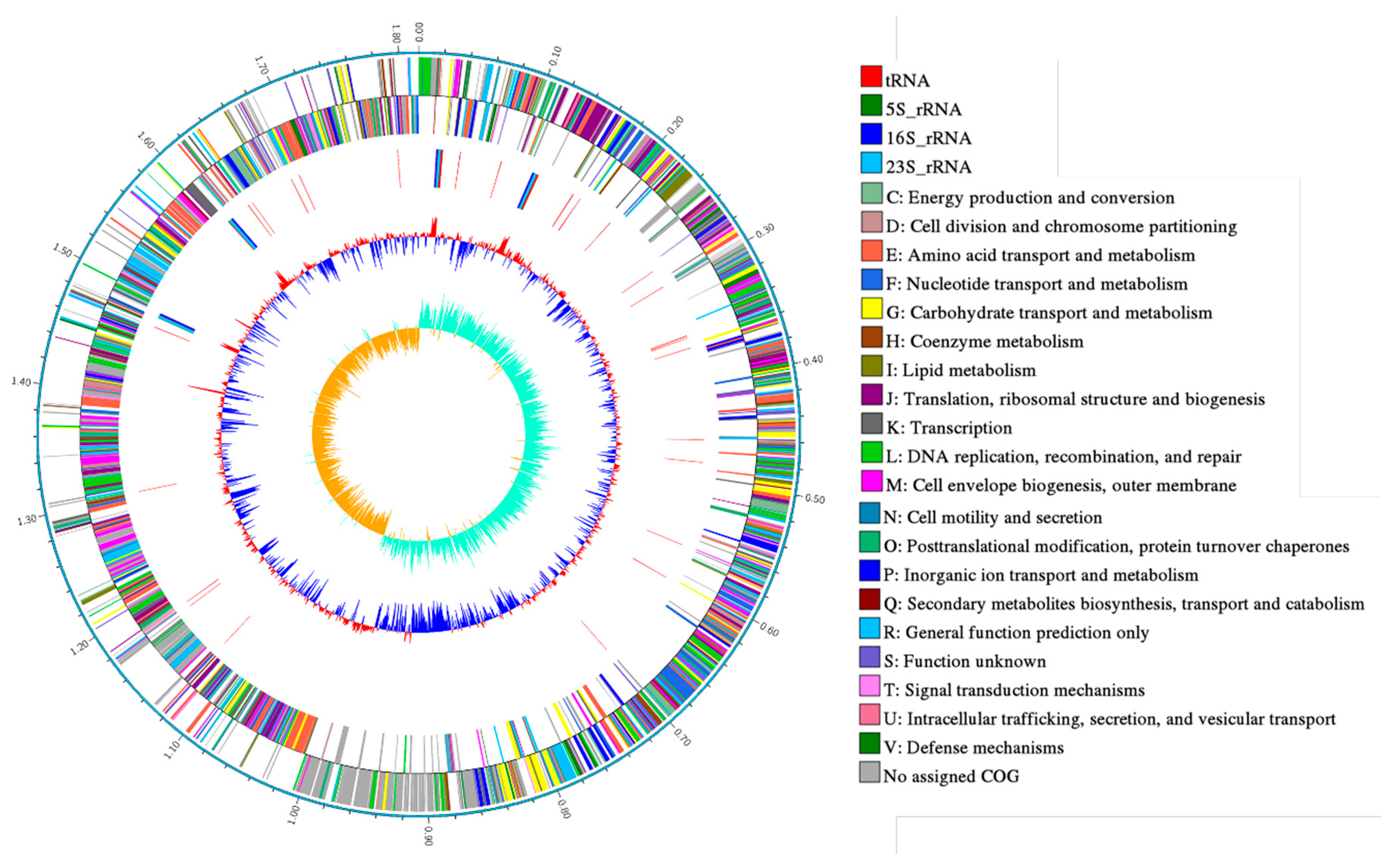
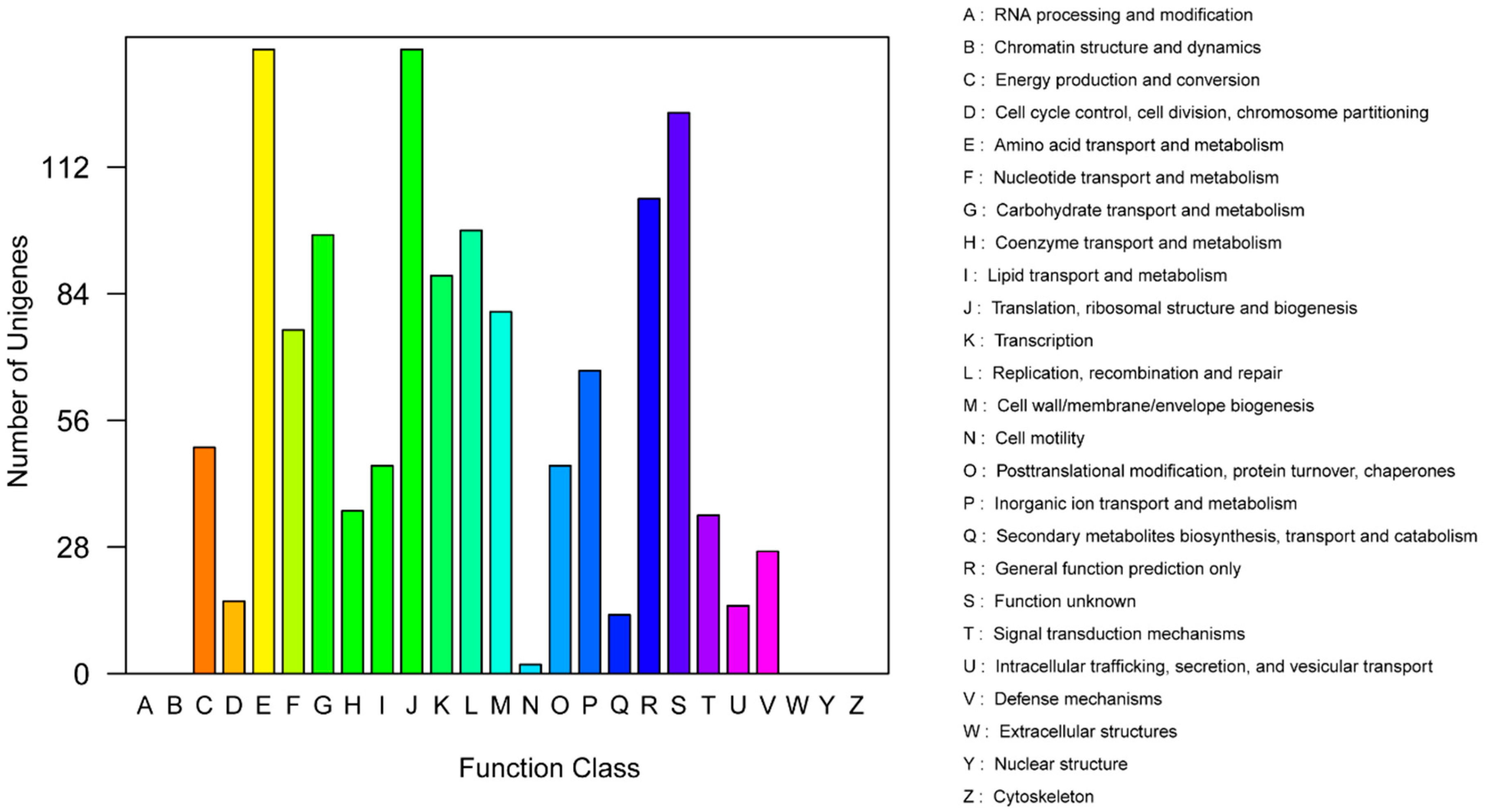

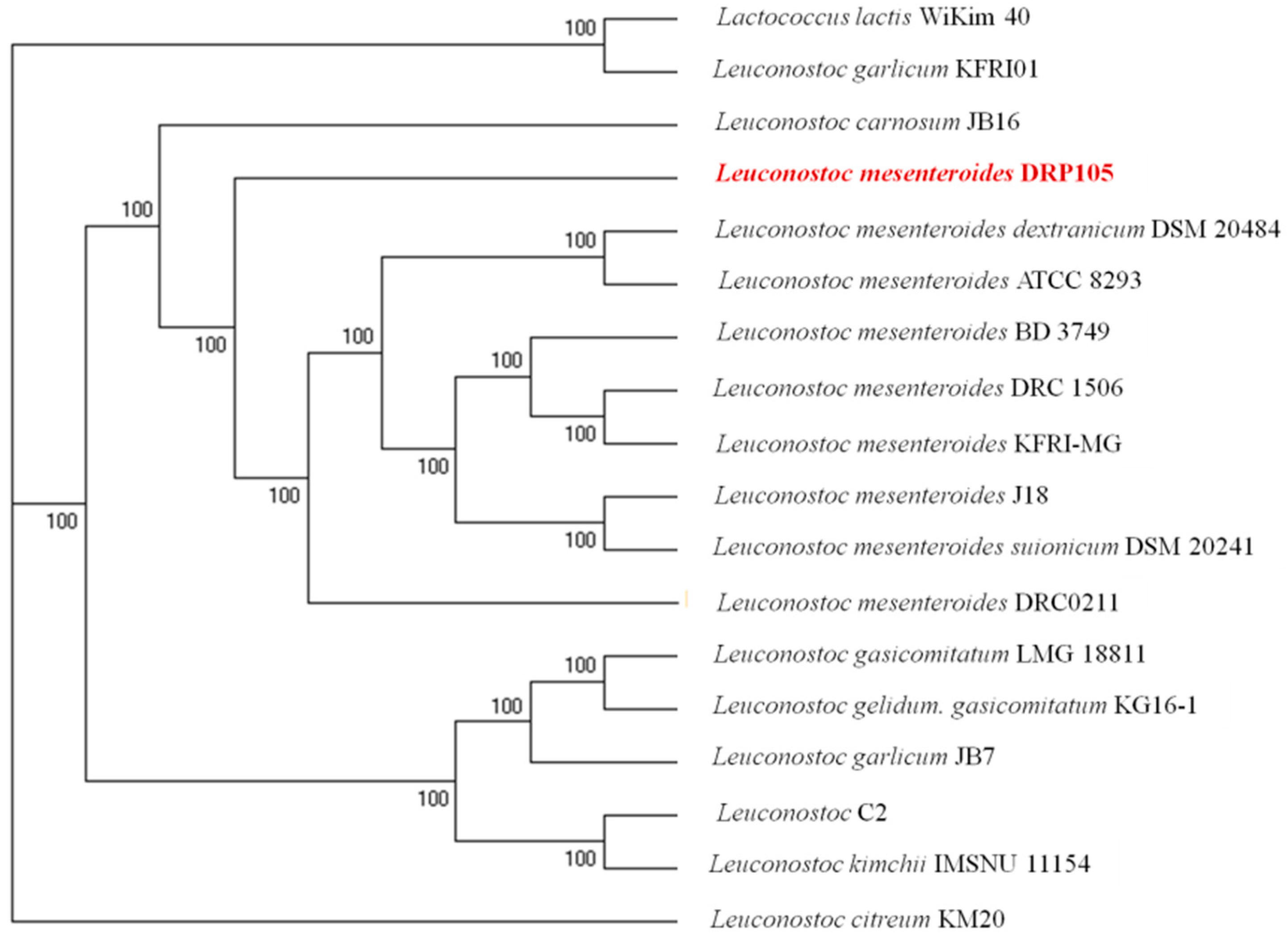
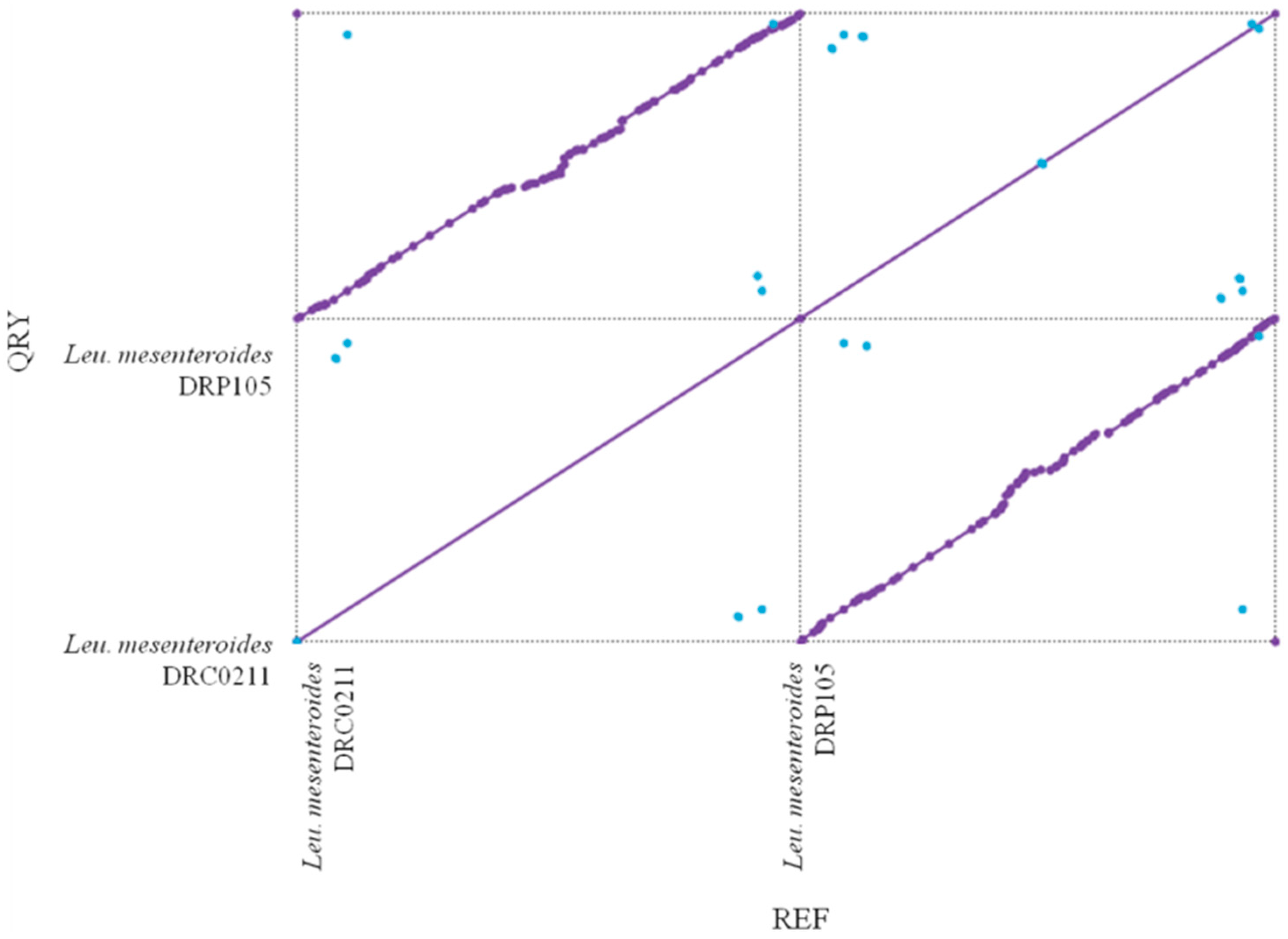
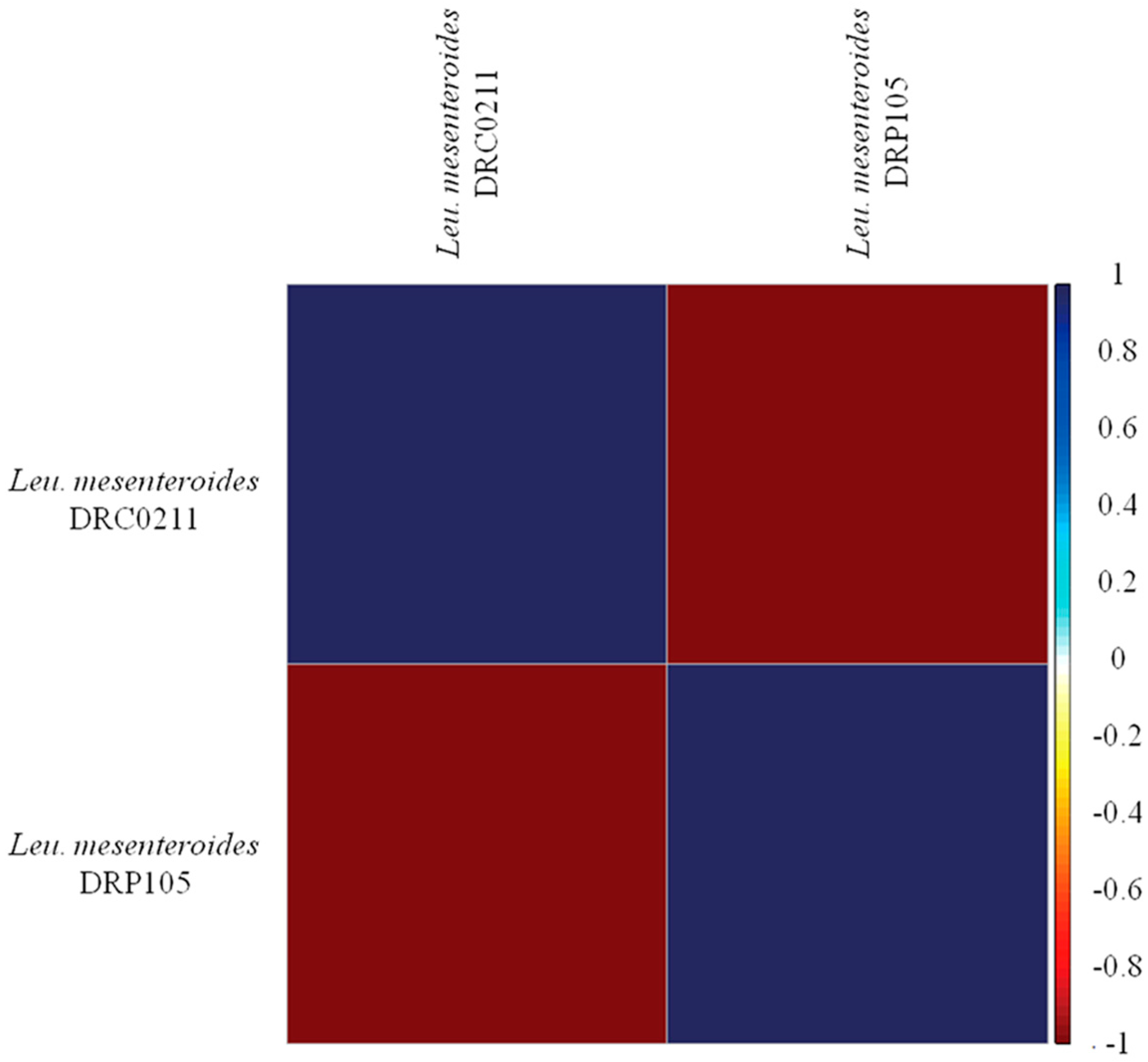
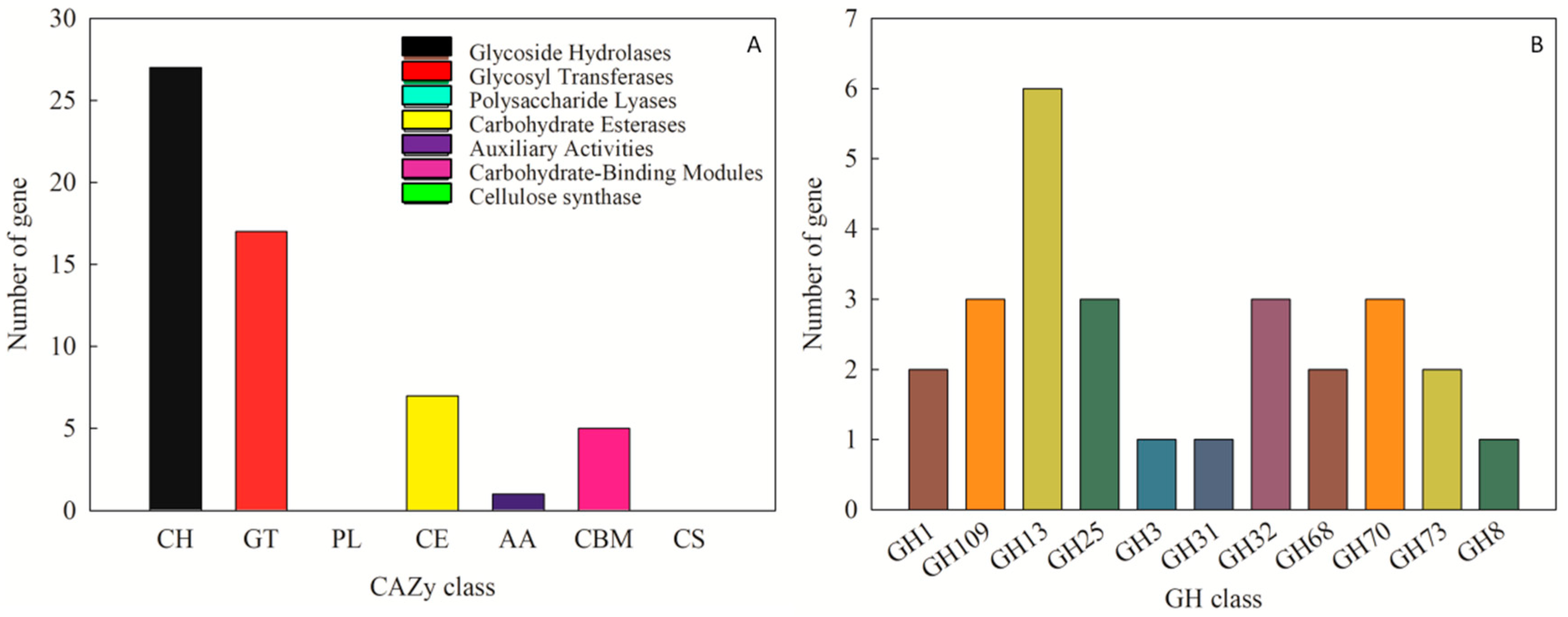

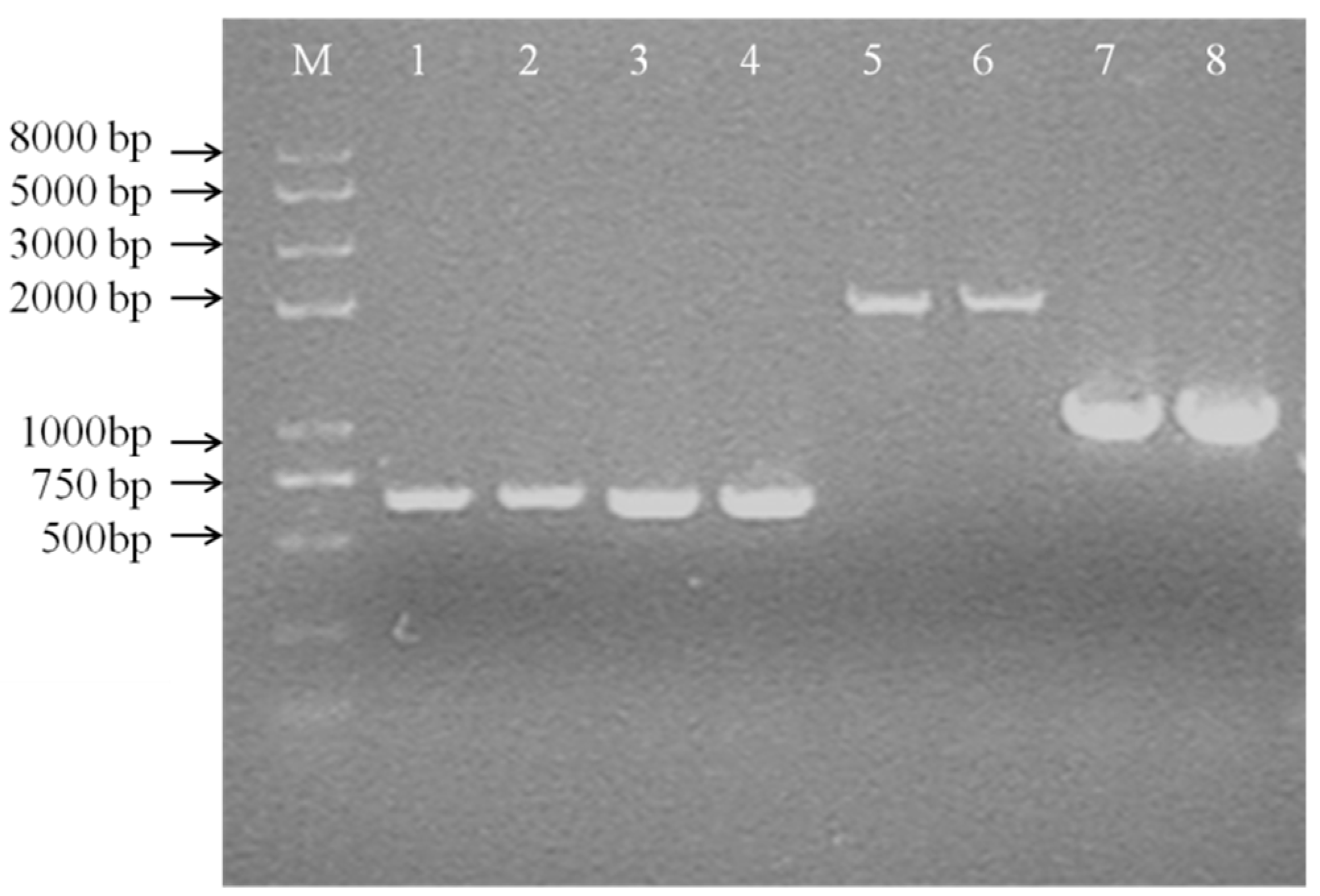
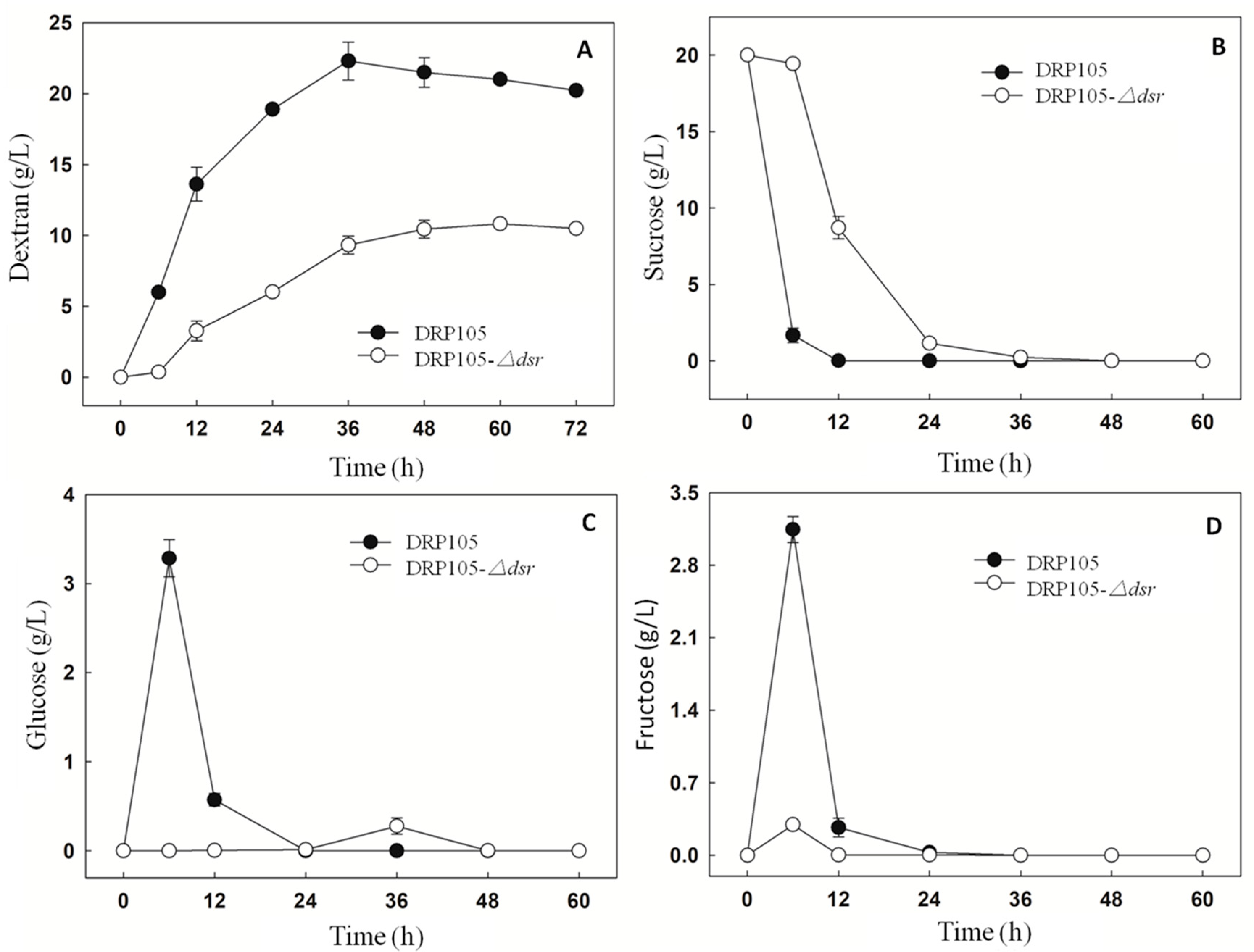

| Statistics of PacBio Raw Data | Leu. mesenteroides DRP105 |
|---|---|
| Total read number | 297,458 |
| Total bases (bp) | 2,715,405,332 |
| Largest (bp) | 49,431 |
| Average length (bp) | 9218 |
| Sample | Chromosome | Plasmid-DRP01 | Plasmid-DRP02 | Plasmid-DRP03 | Plasmid-DRP04 | Plasmid-DRP05 |
|---|---|---|---|---|---|---|
| No. of all scaffolds | 1 | 1 | 1 | 1 | 1 | 1 |
| Bases in all scaffolds (bp) | 1,815,345 | 37,314 | 13,823 | 12,703 | 12,404 | 12,703 |
| Scaffolds N50 (bp) | 1,815,345 | 37,314 | 13,823 | 12,703 | 12,404 | 12,703 |
| G + C content (%) | 37.267 | 35.388 | 36.743 | 35.558 | 35.415 | 37.967 |
| N rate (%) | 0 | 0 | 0 | 0 | 0 | 0 |
| Gene number | 1804 | 49 | 20 | 17 | 11 | 12 |
| Gene total length (bp) | 1,597,347 | 24,591 | 10,311 | 9690 | 10,167 | 4989 |
| Gene average length (bp) | 885 | 520 | 515 | 570 | 924 | 415 |
| Gene density (/kb) | 0.993 | 1.313 | 1.446 | 1.338 | 0.886 | 0.944 |
| GC content in gene region (%) | 37.8 | 36.5 | 38.2 | 35.9 | 35.6 | 33.2 |
| Gene/Genome (%) | 88.0 | 68.3 | 74.6 | 76.3 | 82.0 | 39.3 |
| Intergenetic region length (bp) | 217,998 | 11,823 | 3521 | 3013 | 2337 | 7714 |
| GC content in intergenetic region (%) | 32.8 | 32.8 | 32.2 | 34.2 | 34.1 | 41.0 |
| Intergenetic length/genome (%) | 12.0 | 31.7 | 25.4 | 23.7 | 18.0 | 60.7 |
| Amino Acids | Content (mg/kg) | p-Value | |
|---|---|---|---|
| Leu. mesenteroides DRP105 | Leu. mesenteroides DRP105−Δdsr | ||
| Tau | 0 ± 0 | 0±0 | 1 |
| Asp | 56.0 ± 1.1 | 56.2 ±1.4 | 0.1056 |
| Thr | 82.9 ± 1.4 | 82.4 ± 0.6 | 0.0194 |
| Ser | 68.0 ± 2.3 | 64.5 ± 1.9 | 0.0004 |
| Glu | 42.5 ± 1.0 | 32.4 ± 0.4 | <0.0001 |
| The | 0 ± 0 | 0 ± 0 | 1 |
| Gly | 200 ± 4.8 | 202 ± 3.5 | 0.0012 |
| Ala | 231 ± 3.1 | 238 ± 1.8 | 0.0001 |
| Cys | 24.7 ± 0.3 | 26.2 ± 1.1 | 0.0022 |
| Val | 159 ± 1.6 | 160 ± 2.1 | 0.0050 |
| Met | 89 ± 0.7 | 87 ± 1.5 | 0.0012 |
| Ile | 120 ± 2.3 | 115 ± 3.4 | 0.0002 |
| Leu | 515 ± 1.5 | 506 ± 1.3 | <0.0001 |
| Tyr | 296 ± 2.3 | 287 ± 2.5 | <0.0001 |
| Phe | 341 ± 4.1 | 338 ± 3.7 | 0.0006 |
| g-ABA | 15.9 ± 0.2 | 15.7 ± 1.1 | 0.1056 |
| Lys | 283 ± 2.7 | 282 ± 3.8 | 0.0050 |
| His | 70.6 ± 2.1 | 66.1 ± 1.2 | 0.0002 |
| Arg | 687 ± 4.5 | 681 ± 3.6 | 0.0001 |
| Hypro | 0 ± 0 | 0 ± 0 | 1 |
| Pro | 48.1 ± 1.7 | 44.2 ± 2.1 | 0.0003 |
| Total | 3329.7 ± 5.3 | 3283.7 ± 3.8 | <0.0001 |
© 2020 by the authors. Licensee MDPI, Basel, Switzerland. This article is an open access article distributed under the terms and conditions of the Creative Commons Attribution (CC BY) license (http://creativecommons.org/licenses/by/4.0/).
Share and Cite
Du, R.; Zhou, Z.; Han, Y. Functional Identification of the Dextransucrase Gene of Leuconostoc mesenteroides DRP105. Int. J. Mol. Sci. 2020, 21, 6596. https://doi.org/10.3390/ijms21186596
Du R, Zhou Z, Han Y. Functional Identification of the Dextransucrase Gene of Leuconostoc mesenteroides DRP105. International Journal of Molecular Sciences. 2020; 21(18):6596. https://doi.org/10.3390/ijms21186596
Chicago/Turabian StyleDu, Renpeng, Zhijiang Zhou, and Ye Han. 2020. "Functional Identification of the Dextransucrase Gene of Leuconostoc mesenteroides DRP105" International Journal of Molecular Sciences 21, no. 18: 6596. https://doi.org/10.3390/ijms21186596
APA StyleDu, R., Zhou, Z., & Han, Y. (2020). Functional Identification of the Dextransucrase Gene of Leuconostoc mesenteroides DRP105. International Journal of Molecular Sciences, 21(18), 6596. https://doi.org/10.3390/ijms21186596






